We recently sent The Light in Darkness author Lawrence Kirsch a list of questions about his book documenting Bruce Springsteen's Darkness on the Edge of Town tour. The book is a fascinating mix of fan reminiscences and some killer photography from each stop on the 1978 American tour. It is a beautiful book and something every Springsteen fan will want. It is available at www.thelightindarkness.com but you better hurry. Kirsch reports that there are less than 120 copies remaining from the initial printing of 2800 and there are no plans for a second printing. Mr. Kirsch was also kind enough to provide us with several exclusive photographs that were not in the book.
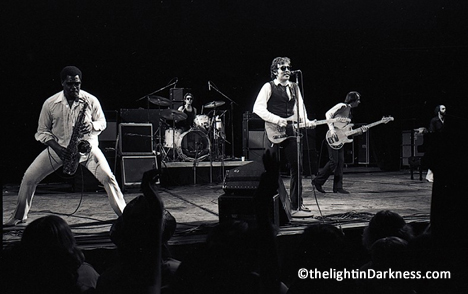
How did you come to undertake this project? As a fan? A photographer?
Both actually. My first book on Bruce Springsteen is called For You, Original Stories and Photographs by Bruce Springsteen’s Legendary Fans. This book was a love letter from the Springsteen fan community to the man himself. I think it is best described by Boston journalist and Springsteen blogger Pete Chianca, in these few lines: “In reading For You, at first it’s hard to believe that one performer could possibly have touched this many people this deeply — lifted them from depression, kept them from suicide, helped them through divorce or the death of a parent, or worse, a child. But story after story reveals just how much Springsteen’s music and his almost superhuman presence on the concert stage have penetrated people’s lives and, in as much as it is possible for music to do so, made them whole.” While For You is a compilation of stories and photos from Springsteen’s entire career as of that time (1969-2007), The Light in Darkness focuses on his fourth album and 1978 Tour for Darkness on the Edge of Town, which just happens to be my favourite. So, truth be told, it was partly a selfish act.
Why “Darkness?” What’s your relationship to this album/tour?
In 1978 I had already been working as a professional photographer for a couple of years when I first photographed Elvis Costello for CBS records. Before 1977 I was hired on a freelance basis photographing many major rock acts of the 70s, including David Bowie, Bruce Springsteen, The Rolling Stones, Bob Dylan, Pink Floyd and Elton John. Based in Montreal, I traveled extensively throughout Canada and the United States for concert photo sessions commissioned by magazines and record labels WEA, CBS, Capitol, MCA, and RCA. Even though I had seen and shot all the above artists, nothing prepared me for the first time I saw Bruce Springsteen in concert in 1975. I remember having tickets in the balcony and feeling that Bruce was playing to me all night. I remember Bruce coming on stage in the dark to start the show, one blue spotlight on Roy Bittan while he played the slow introduction to Thunder Road. I had seen and photographed many shows before then, but nothing as dramatic as that. His interaction with the audience, the stories he told, and the incredible musicianship of the E Street Band were all new experiences for me. After 1975 Bruce disappeared, at least for me, with no new album and no concert dates in my area for three years. So when I received a call from my cousin living in Buffalo inviting me to attend Bruce’s premiere show to showcase his new album, I was psyched.
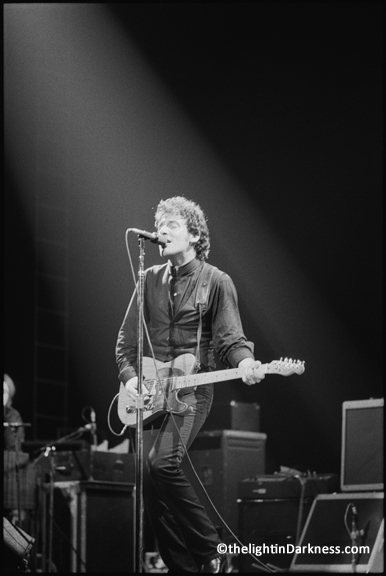
May 23, 1978, Buffalo, New York. I was there when Bruce broke out of creative jail. The night Bruce was able to perform new songs how and when he wanted to. What I remember most was the raw emotion that Bruce presented on stage. I would even say he was nervous, a bit tentative. But by the time he launched into “Something in the Night” and screamed so his body shook, we knew he was going to take no prisoners, even if it killed him, and us. I had been anticipating this show for close to three years. The audience and atmosphere were electric, we had no idea what to expect, as the new album Darkness on the Edge of Town had not been released yet. I remember the thick smell of marijuana when I walked into the grand old theater, and the humid heat of the air. I remember superfan Obie and photographer/girlfriend Lynn Goldsmith hanging out in the first row waiting with anticipation like the rest of us for the lights to go down.
And then it started. There was an edge to the performance, something to prove, that Born to Run wasn't the hype many made it out to be, and that Bruce and the E Street Band belonged. One of the reasons that the '78 tour is so highly thought of isn't just the performances but the fact that Bruce was still a cult artist (albeit a large cult) and that the venues were mostly smaller theatres where the audience could more easily bond with the performers. It seems that the shocking death of one of Bruce’s heroes, Elvis Presley, about eight months before the tour began, combined with Springsteen wanting to prove he could do it all, on his own terms, led to this landmark tour. It was the history of rock and roll, past, present and future, in three hours.
The real revelation was Bruce's guitar playing which never was so passionate. He poured his soul out on those songs in a way that the album can only hint at. If fans say they don't like "Adam Raised a Cain" or "Streets of Fire," they would quickly change their mind if they heard them on that tour. The Darkness shows, that was something I had never seen before, a rock performer laying it all out on the line and asking you to come aboard for the ride. And this was a dark ride. Bruce's rendition of "Prove It All Night" in 1978 was everything that was so special about that tour in one viewing. It was loud, it was challenging, it was dramatic, and it was totally unexpected.
I remember at the three shows in New York the standard rap before the first encore song (the three at MSG were "Born to Run," "Because the Night," and "Quarter to Three"), Springsteen would thank us, “I wanna thank everybody for coming down to the show…I’d like to thank you for your support over the past two or three years when we were going through the hard times.” He would say something about people coming up to him during the lawsuit blackout period and saying that they were still with him, waiting for the new album, and how much that meant to him. And then he would say, "This is for you" and absolutely tear into "Born To Run." Great stuff. Made you feel special.
I was fortunate to attend nine shows on the Darkness tour, including the opening show in Buffalo and the last two in Cleveland. I have photos I took from six of the shows reproduced in The Light in Darkness. Shooting Bruce during this tour was one of the most memorable events of my career.
Many fans found the new LP a bit difficult to appreciate; it was miles away from Born To Run. And yet, right out of the gate, Bruce took the new songs and gave each one a vivid, searing intensity that could not be denied. He was putting across his message, his vision of who he was at 29, and where he was going to take the music, and you. And, of course, when fans went home and revisited Darkness on the Edge of Town, it suddenly all made sense, and had a firm place in their hearts and minds.
All this and more is why the tour still resonates. And always will.
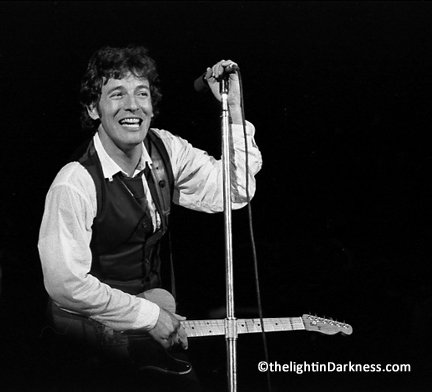
How were you able to source all of the photos?
I was able to contact all the same photographers that contributed amazing original photography to the For You book, and beyond that several of the top Springsteen blogs and fan web sites such as Backstreets.com, Greasylake.com, Stan Goldstein’s Springsteen blog, and Blogness on the Edge of Town were very generous in helping spread the word to the Springsteen fan community.
The text submissions were quite revealing. How did you source those?
The main source for the story submissions was the web site I created for The Light in Darkness book. It consisted of much of what you see posted now, except the main focus was a story submission page where we requested stories dealing with fan’s experiences with either the Darkness album or tour, or both. They provided me with fantastic material to work with, original stories, photographs and scans of memorabilia came pouring in, all contributors interested in making the tribute volume as great as it could be.
The outpouring of responses was overwhelming. For For You, I asked for story contributions of no longer than 300 words. Several fans who felt this was to constricting contacted me personally and asked if they could send longer stories via email. For The Light in Darkness I increased the word count to 400 words, and permitted contributors to include 3-4 lines of lyrics from any one Springsteen song. From the start I had a clearer more focused idea of the chronological order of the way we were going to sequence the content in The Light in Darkness.
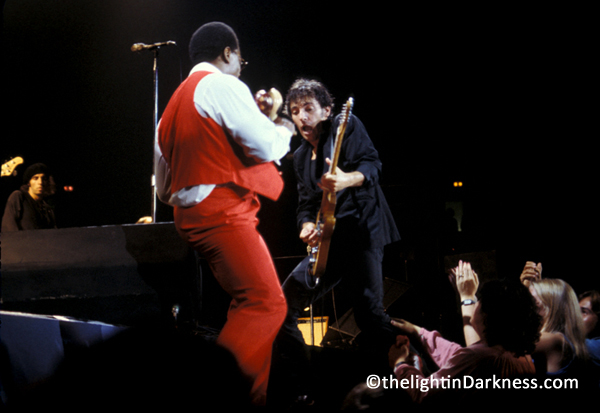
What is your favorite photo in the book? Why?
That is a very tough question to answer, there are several. One of the most unexpected and coolest photos came from Ross Gadye who provided a photo of Bruce on a New York street outside the Record Plant holding a cassette tape demo of Darkness tracks. The shot was taken in October 1977, a full eight months before the Darkness album was released. Another group of photos that I really think captures the spirit of Springsteen on this tour is the photo essay running five pages by P. Jay Plutzer. The photos are from several different venues during the tour and captures many different emotions and highlights, from the dramatic, to exhilaration, from darkness to the sheer intensity of a guitar solo.
What is your favorite fan story in the book? Why?
Again, not easy to select just one, but I have to say one of my favourite Springsteen stories not only in the book, but of all time, has to be Brian Schmuck’s journey of how he managed to attend one of the most iconic concerts of Springsteen’s career, the Agora in Cleveland, Ohio, August 9, 1978. Brian had contacted me to say that he had an interesting story to contribute to the book, but he needed more than the 400 words permitted by the submission form. I readily agreed as I had only ever spoken to one other person who had witnessed that historic show, the late Joey Juhasz, one of the famous Cleveland Boys. What Brian sent in was an eight thousand word rollicking roller coaster ride of a story that most fans would not believe until they read it themselves. Plus, to add even more excitement to this story, we were able to score a huge coup by securing the reproduction rights to the original photography of Robert J. Ferrell, one of only two photographers permitted to photograph the entire Agora concert!
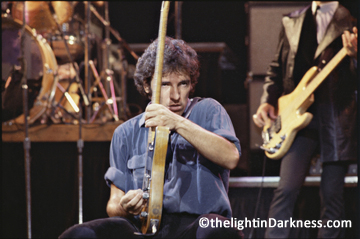
- AMB Blog's blog
- Log in or register to post comments
